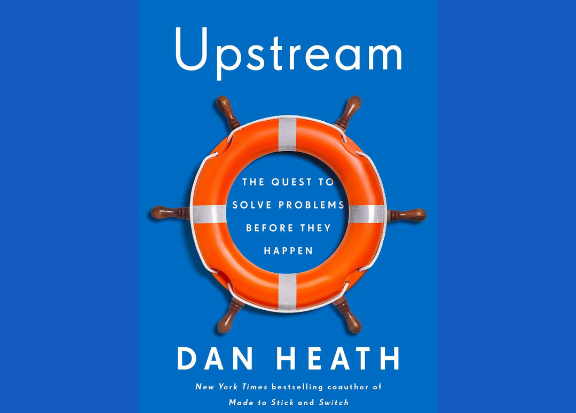“Upstream: How to Solve Problems Before They Happen”
By Dan Heath
So often, in both our work and our personal lives, we get trapped in reaction mode. We address emergencies as they come up, but we don’t dedicate the time and attention to examining the broken systems that cause the emergencies. In other words, we wait for problems to find us downstream instead of going upstream to understand where those problems came from.
For example, in 2012 an executive at the travel website Expedia realized that after booking a trip, 58% of customers placed a call to the help center afterward. This staggering number of calls kept the call center busy around the clock. And while the person in charge of the call center worked hard to optimize customer service and reduce the time it took to solve each customer’s problem, measured by minutes spent on the call, no one in the company had stopped to think about how they could change the customer experience online to prevent those calls in the first place. With some investigation, this executive’s team learned that the number-one reason customers called was to request a copy of their itinerary. The customer had entered his or her email address incorrectly and never received it. By adding an automated option to the voice-response system (“Press two to resend your itinerary”) and a few fixes on the website, the company eliminated 20 million calls to the call center per year.
Eliminating the calls is what author Dan Heath calls an “upstream” solution, and his book of the same name seeks to empower people across organizations to think about problems differently so they can intervene earlier in a system and make a big positive impact on outcome.
When it seems so obvious that “upstream” solutions are more effective, why do we tend to favor reaction over prevention? Heath points out that reaction is more tangible. Police officers who write a lot of tickets have concrete evidence to show for their time, even though an officer who builds community relationships almost certainly prevents more crimes over the long haul. Another problem is that “downstream” reaction behaviors are typically straightforward and simple, whereas prevention becomes more complex and difficult to measure the further upstream you go. We can prevent crime by investing in brighter street lights or by funding community programs for high school students or by making sure teen mothers have access to good nutrition and housing during their pregnancies, making those babies less likely to engage in criminal behavior in adulthood. That last one might make the most impact, but it could be years before we would know, and even then it would be impossible to establish a causal relationship. Finally, upstream problem-solving is unpredictable. It can lead to world-altering solutions like the eradication of smallpox through mass vaccination efforts or unintentional consequences when we monkey with systems we don’t fully understand.
Still, despite its challenges, upstream thinking is an incredibly powerful approach for leaders of all kinds to embrace.
What are the barriers to upstream thinking?
Problem Blindness: Trainers in the NFL used to believe that hamstring injuries were inevitable: they were blind to the problem and so they couldn’t take proactive steps to prevent injuries. Then along came trainer Marcus Elliott, who realized that one-size-fits-all training regimens were to blame. Using more detailed analysis, Elliott studied each player’s performance to spot signs of muscular imbalances and assigned high-risk players to customized off-season training to correct the problems before they became injuries.
A Lack of Ownership: In 1975, pediatrician Seymour Charles wrote an article in the journal “Pediatrics” encouraging pediatricians to talk to their patients about using car seats. Sky-high fatality rates among children in car accidents was not a problem pediatricians had caused, or even saw as having much to do with their work. But they were the best positioned to solve that problem because they had access to the people who could make safer choices.
Tunneling: When people are juggling a lot of problems, they give up trying to solve them all. The lack of bandwidth to think about the big picture confines them to short-term, reactive thinking. They are in the tunnel. To solve this you have to create urgency around a problem that may not happen for a while.
Want to be an Upstream Leader? Here are seven questions you should ask:
- How will I unite the right people? Who is best positioned to be part of the team and how can you help bridge the gaps between them?
- How will I change the system that creates the problem? A well-designed system is the best upstream intervention.
- Where can I find a point of leverage? This requires getting close to the problem to figure out the best place to intervene.
- How will I get early warning of the problem? When we can foresee a problem, we have more maneuvering room to fix it.
- How will I know we’re succeeding? With upstream efforts — which are often about prevention — success is not always self-evident. How can you measure?
- How will I avoid doing harm? Changes to systems can have unintended consequences, but we can’t succeed by foreseeing the future. Instead, we have to try, collect data, and adjust.
- Who will pay for what does not happen? Preventing a problem requires an investment of resources, sometimes by another party than the one who will benefit from the solution.
Upstream work hinges on humility. The further upstream we go to solve a problem, the more complex both the problem and the potential solutions become. We tend to want to bluff our way through that complexity, or we freeze in the face of it, but with humility and determination, we can choose a third option: to learn and try again. “The best time to plant a tree is 20 years ago,” as the old proverb says, “but the second-best time is now.”

